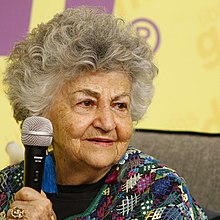Rosa Nissán
Rosa Nissán | |
|---|---|
 (2017) | |
| Born | Rosa Nissán Rovero June 15, 1939 Mexico City, Mexico |
| Occupation | Writer |
| Language | Spanish |
| Alma mater | Women's University of Mexico |
| Genre | Novel |
| Notable works | Novia que te vea |
| Notable awards | Ariel León Dultzin Award |
Rosa Nissán Rovero (known as Rosa Nissán; born June 15, 1939) is a Mexican writer of Sephardic origin.[1][2] She is the author of the novel Novia que te vea (1992), which was made into a movie.[3] She received the Ariel León Dultzin Award, from the Association of Israeli Journalists and Writers in Mexico, in 1994.[4]
Biography
Rosa Nissán Rovero was born in Mexico City on June 15, 1939. She studied journalism at the Women's University of Mexico.[1]
In 1992, she published her first novel Novia que te vea. It was made into a film, produced by Instituto Mexicano de Cinematografía and directed by Guita Schyfter, with a script co-written by Nissan and Hugo Hiriart. The novel addresses the issue of cultural integration of Jewish communities in Mexico and questions the traditional role of Jewish women, as well as the customs and traditions of the Sephardic community.[4][5][6][7]
In 1997, she published a chronicle of her trip to Israel in Las Tierras Prometidas (The Promised Lands).[4] Two years later, her second novel was published, Hisho que te nazca, a continuation of Novia que te vea, and that same year, some short stories were also published in No sólo para dormir es la noche (Not only to sleep is the night), where she brings together a collection of stories in which the problems of partner and loneliness are determining factors.[4][8]
From 2000 to 2002, she gave various workshops on fictionalized autobiography in the Casa del Lago Juan José Arreola, at the University of the Cloister of Sor Juana. and the Casa del Refugio.[3][1]
Selected works
- Novia que te vea, 1992, Planeta.
- Hisho que te nazca, 2006, Planeta.
- Las tierras prometidas, 1997, Plaza & Janés.
- No solo para dormir es la noche, 1999, Patria.
- Los viajes de mi cuerpo, 1999, Planeta.
- Me viene un modo de tristeza
References
- ^ a b c "Rosa Nissan - Detalle del autor - Enciclopedia de la Literatura en México - FLM - CONACULTA". www.elem.mx (in Spanish). Retrieved 12 March 2023.
- ^ Nissán, Rosa. "Rosa Nissán". Enlace Judío (in Mexican Spanish). Retrieved 12 March 2023.
- ^ a b "Rosa Nissán, Entre la autobiografía novelada y la identidad Sefaradí. Autora de Novia que te Vea, entre otros". diariojudio.com (in Spanish). 28 May 2014. Retrieved 12 March 2023.
- ^ a b c d "Escritores Sefaradíes: Rosa Nissán Rovero (México, 1939)". eSefarad (in Spanish). 24 February 2017. Retrieved 12 March 2023.
- ^ Bautista, Virginia (16 November 2015). "Rosa Nissán vuelve con 2 libros". Excélsior (in Spanish). Retrieved 12 March 2023.
- ^ Halevi-Wise, Yael (1998). "Puente entre naciones: idioma e identidad sefardí en Novia que te vea e Hisho que te nazca de Rosa Nissán". Hispania. 81 (2): 269–277. doi:10.2307/345015. ISSN 0018-2133. JSTOR 345015. Retrieved 12 March 2023.
- ^ Scott, Renée (30 December 1998). "La experiencia sefardí en Latinoamérica: Tres novelas de Teresa Porzecanski y Rosa Nissán". Sefarad (in Spanish). 58 (2): 387–399. doi:10.3989/sefarad.1998.v58.i2.826. ISSN 1988-320X. S2CID 159631093. Retrieved 12 March 2023.
- ^ Obra publicada - Enciclopedia de la Literatura en México - FLM - CONACULTA (in Spanish). Retrieved 12 March 2023.
{{cite encyclopedia}}:|website=ignored (help)
